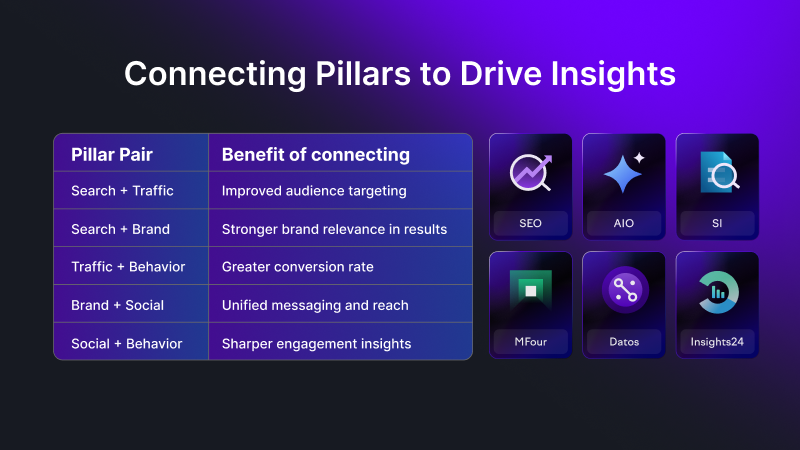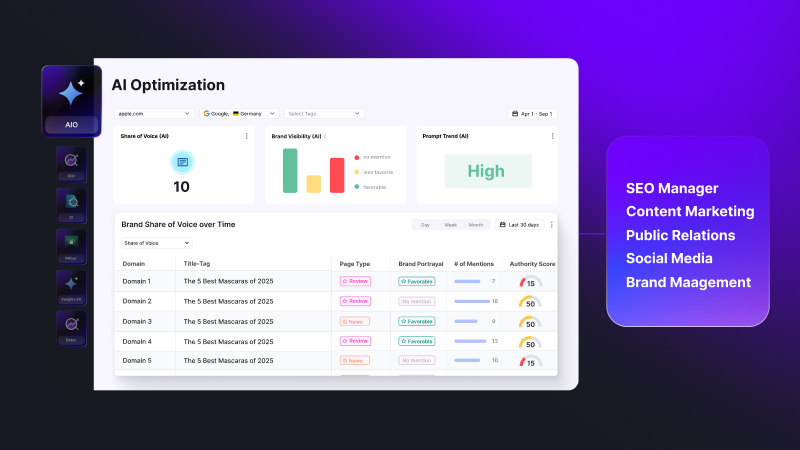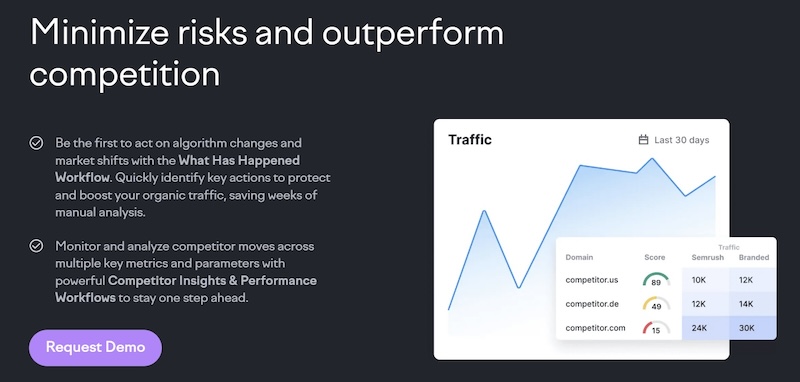5 marketing maturity levels: From siloed to autonomous by Semrush Enterprise


Martech debt builds up through manual reporting, fragile integrations, and silos. These issues fragment customer data, break campaign attribution, and force teams to rely on shadow spreadsheets to fill gaps between platforms.
Current maturity models focus on technology adoption (hello AI!) rather than business outcomes. This misses the structural shift required to escape this cycle.
Semrush Enterprise evaluates maturity across five interconnected pillars:
- Search
- Traffic
- Behavior
- Social
- Brand
Progress means moving from patchwork operations to a unified engine where insight, execution, and impact connect and scale together for strategic effect.

Marketing maturity progresses through five interconnected levels, each marked by deeper integration and growing automation roles across digital marketing specialties.
Level 1: Siloed
Teams hit individual goals but miss collective impact.
Teams operate as isolated units, protecting their own metrics while critical insights die inside departmental boundaries. Individual goals get hit while campaigns lose ground because no one understands cross-pillar impact.
Silos block productive feedback loops: teams deepen expertise but miss the compounding lift when signals transfer.
Isolated metrics become absolute targets (Goodhart’s Law), pushing teams to game numbers at the expense of real growth while eroding the unified experience customers expect.
At this level, every pillar runs its own optimization race, blind to system impact and blind to what real performance should look like. The results?
- Fragmented customer data.
- Inconsistent messaging across touchpoints.
- Broken attribution.
Spot the symptoms of a siloed marketing department
Siloed operations generate specific, identifiable symptoms such as:
- SEO and PPC campaigns run in parallel; no knowledge is shared.
- Funnel drop-offs are reported but never explained.
- PR teams measure media coverage volume but have no concept of SEO outcomes.
- The content team drives engagement, but the data isn’t handed off, so no other team learns.
Concrete example : the Lidl case study

A viral TikTok case study presented by Mathilde Høj from TRANSACT Denmark at BrightonSEO demonstrated how TikTok content can dramatically impact search behavior and website traffic.
SEO and social media teams operated in silos, meaning when viral TikTok content drives massive search demand, the brand lacks the cross-functional collaboration needed to capitalize on it.
The disconnect becomes particularly costly when organic social teams identify what’s resonating with audiences in real-time, but paid/performance teams and SEO teams have no visibility into these insights to act quickly.
Ultimately, siloed workflows prevent brands from delivering a unified customer journey across discovery, consideration, and conversion.
Level 2: Connected
Faster problem solving and leaner workflows
At Level 2, teams connect some dots manually, creating symbiosis (i.e., interdependent relationships between search, traffic, behavior, social, and brand).
Campaigns can now pivot faster and answer “what’s working?” with a bit more clarity.
Leaner workflows, selective data sharing, and better targeting all drive sharper engagement and conversions.
In the real world, it can look something like this:
- When social media shares drive engagement signals to content optimized for search.
- SEO often gains from brand awareness campaigns that increase branded search volume, even when brand teams don’t optimize specifically for organic search.
Search engines value cross-channel signals: social media interactions generate social signals that indirectly influence SEO through increased content reach and backlink opportunities. When users share and engage with content across platforms, it signals relevance and authority. Social media profiles now appear in search engine results pages (SERPs), creating additional brand touchpoints.
Quick win: Pair up two specialties for a quarterly project. Demand a shared outcome and document what worked.

Dig deeper. SEO & Content Playbook for Agencies with Andy Crestodina.
Level 3: Integrated
Shared KPIs locked by cross-functional playbooks
Integrated marketing teams hit revenue and scaling goals faster because every team stays focused on shared objectives while customizing tactics to get the best results for each channel.
Every specialist knows where their work plugs into the pipeline.
Real-time feedback and joint campaign planning become the new default and help achieve compounding results.

Concrete example: automated internal linking
Picsart, a creative design platform serving millions of users across 17 languages, identified pages needing optimization but lacked a systematic way to prioritize internal linking. Scaling manually across 300+ pages would have consumed 12,500+ hours.
Semrush Enterprise’s Link Recommender deployed 50,000+ contextual links in one week, creating pathways that matched user intent at different journey stages: visitors researching “photo editing” could now flow seamlessly to specific feature pages, then to templates.
The automation increased clicks by 20% over a period of 2 months.
Senior Product Manager Niels Kaspers emphasized the automation didn’t eliminate the team’s role: it shifted them from tactical linking grunt work to strategic content prioritization and forecasting which new pages would deliver more clicks.
This demonstrates how Level 3 automation builds bridges between user behavior insights and technical execution while freeing capacity for strategic work.
Level 4: Predictive

Algorithms detect patterns and forecast outcomes faster than human analysis, enabling proactive resource allocation before opportunities close or risks materialize.
AI forecasts outcomes before execution, freeing strategic capacity
AI models connect signals across pillars to forecast outcomes before they materialize. At this level, the marketing system stops reacting to what happened and starts preparing for what will happen.
Predictive analytics builds on integrated foundations, using cross-channel patterns to anticipate customer behavior, campaign performance, and revenue trajectories before teams execute.
Instead of fixing problems after they occur, predictive systems surface trends, redirect resources in real time, and enable proactive intervention.
What predictive looks like in practice with Square
What previously took months of manual analysis now happens in seconds. When algorithm updates hit or traffic drops, Square’s teams can open Semrush Enterprise, run the “What Has Happened” automation, and respond before competitors even understand what changed.
Predictive SEO forecasting shows:
- Which content optimizations will move rankings.
- Which markets offer untapped opportunity.
- Where competitors are gaining ground.
Systems identify high-impact opportunities across markets and channels automatically, then surface them to teams for strategic execution rather than waiting for manual discovery.
This freed 12 hours per week for strategic work while AI handled diagnostic detection. Square made a point of focusing its attention on content.
Running AI-powered content audits allowed visibility of the competitive gaps and opportunities, which could immediately be deployed into their predictive SEO forecasts. Now they could understand which content changes would move rankings most, allowing prioritization of high-impact optimizations rather than guessing.
These could then instantly be shared across their nine global markets to scale the impact.
The system surfaced “high-impact opportunities across markets” that Square’s human team hadn’t detected, enabling the company to adapt strategies, optimize content, and capture growth opportunities in real time ahead of competitors.
Level 5: Autonomous
Spend time on growth, not management.
The autonomous marketing system self-optimizes across all pillars with minimal human input: spend, content, reporting, and optimization adjust in real time without manual intervention. Teams step in by exception when strategic judgment, creative vision, or crisis response requires human expertise.
Most marketing organizations remain at Levels 2–3. A 2025 automation maturity study found that autonomous operations require foundational work most companies have not completed:
- Fully integrated cross-channel data.
- Machine learning models trained on business-specific outcomes.
- Governance frameworks defining when systems act independently versus escalating to humans.
Autonomous marketing requires clean, connected data flowing across every channel. This requirement conflicts with the fragmented martech stacks most teams use.
Signals of autonomous operation:
- Campaigns run fully automated with optimization loops adjusting creative, targeting, and budget allocation without manual input.
- Budgets shift automatically based on real-time ROI calculations, freeing teams to innovate rather than manage spreadsheets.
- Brand monitoring runs continuously, flagging humans only when risk thresholds are breached.
- Crisis playbooks trigger automatically from AI pattern detection, replacing reactive emergency meetings.
What if autonomous operation feels distant?
Identify one high-volume, low-complexity marketing task and automate it with clear exception rules defining when the system escalates to a human.
Document decision triggers that remain human-only:
- Brand messaging approval.
- Crisis response.
- Budget reallocation above certain thresholds.
Most organizations will operate as hybrid systems for years, with autonomous operations handling defined tasks while humans manage judgment calls, cross-functional strategy, and organizational change required to reach full integration.
Marketing maturity is not a technology checklist
Organizations stuck buying tools without integrating systems perpetuate the martech debt cycle. This fragments data and burns out teams while competitors who build connected foundations capture compounding returns.
The path forward starts with an honest assessment: identify which level describes current operations. Then, focus on one cross-functional integration project that demonstrates symbiotic value.
Progress happens through deliberate structural shifts (e.g., connecting silos, establishing shared KPIs, automating tactical work) not through adding another platform to an already fragmented stack.






Recent Comments